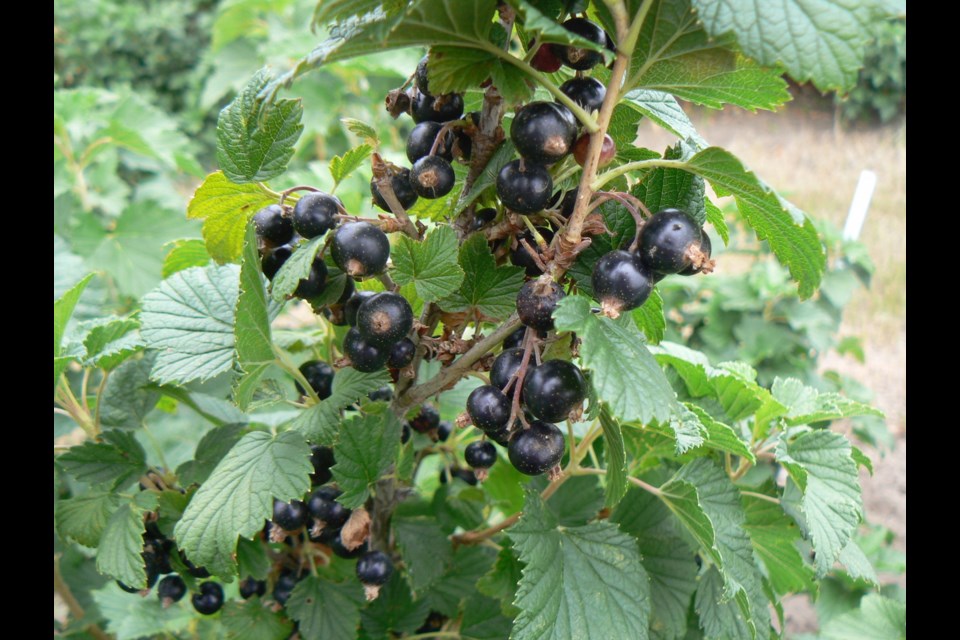Hardly anything beats the flavour of homemade black currant ice cream, unless it's currant syrup, jelly, wine or port. Yet relatively few Canadian gardeners grow currants. Part of the reason was the prohibition of their growth in the United States, beginning in the late 1800s, when it was discovered black currants were an alternate host for the fungus that causes white pine blister rust. In Canada, their growth was strongly discouraged. With the introduction of resistant varieties of both pines and currants, by the 1960s, most restrictions were lifted or no longer enforced. But the 60-year ban left several generations of North Americans totally unfamiliar with the taste of currants.
There are over 150 species of Ribes, mostly native to Europe, Asia and North America. The most widely grown on the prairies are the black currant (R. nigrum), red and white currants (R. odoratum), the gooseberry (R. uvacrispa and R. grossilata) and the golden currant (R. aureum and R. odoratum).
Currants and gooseberries are long-lived, prickly shrubs with a height and spread of 1 to 1.5 m (3-5 ft.). Most are "well behaved" in that they stay put and do not sucker. Their roots are thin and very shallow. Most have small, inconspicuous, cream coloured flowers. The exception is the golden currant that has larger, bright yellow flowers with red centres and a sweet licorice-like fragrance. Its common name is based on the flower colour and not the fruit colour. Berries are commonly black, but some may be red or yellow.
For good yields, black currants require the presence of at least two compatible varieties. Other Ribes can be planted as single varieties. But different species of Ribes will not pollinate one another. All are insect pollinated, so avoid the use of broad-spectrum insecticides.
Species
Black currants are the most widely grown. The berries are about 1 cm across with an intense flavour. Although seldom eaten fresh, they are excellent in juice, wine, liqueur, ice cream, jam, jelly, syrup and candy. Much of the breeding has been carried out in Scotland. Black currants are very hardy. When varieties from around the world were grown at the University of Saskatchewan, all of them proved hardy, including those from Scotland!
* 'Ben Connan' has large, easy to pick berries on upright plants.
* 'Ben Nevis', resistant to rust, also has large, firm berries.
* 'Ben Sarek' has large, firm berries that ripen in mid-season. The bushes are very productive, only 1 m in height, and resistant to mildew and rust.
* 'Willoughby', introduced by Bert Porter of Parkside, Sk., has very reliable fruit production and is highly resistant to mildew.
Red and white currants are smaller than black currants and formed in long trusses. They are seldom eaten fresh but are good for processing.
* 'Red Lake' is very productive with large red berries in long clusters on upright, vigorous plants. They are excellent in jellies, syrup and wine.
* 'White Pearl' produces long clusters of pale yellow, translucent berries with a sweet, mild flavour. They can be eaten fresh or used in pies and jelly.
Golden currants, also called clove, buffalo or Missouri currants, are sometimes sold as ornamentals. They have yellow flowers but black fruit. The berries are larger and milder than those of black currants and are often eaten fresh. The plants are larger than those of currants and will sucker if left untended. They are very drought tolerant once established. Their flavour is similar to that of black currants but milder and considered more enjoyable to eat fresh. No varieties are currently (pun!) available.
Sara Williams is the author and coauthor of many books including Creating the Prairie Xeriscape, Gardening Naturally with Hugh Skinner and, with Bob Bors, the recently published Growing Fruit in Northern Gardens. She continues to give workshops on a wide range of gardening topics throughout the prairies.
This column is provided courtesy of the Saskatchewan Perennial Society (SPS; [email protected] ). Check our website (www.saskperennial.ca) or Facebook page (www.facebook.com/saskperennial) for a list of upcoming gardening events




